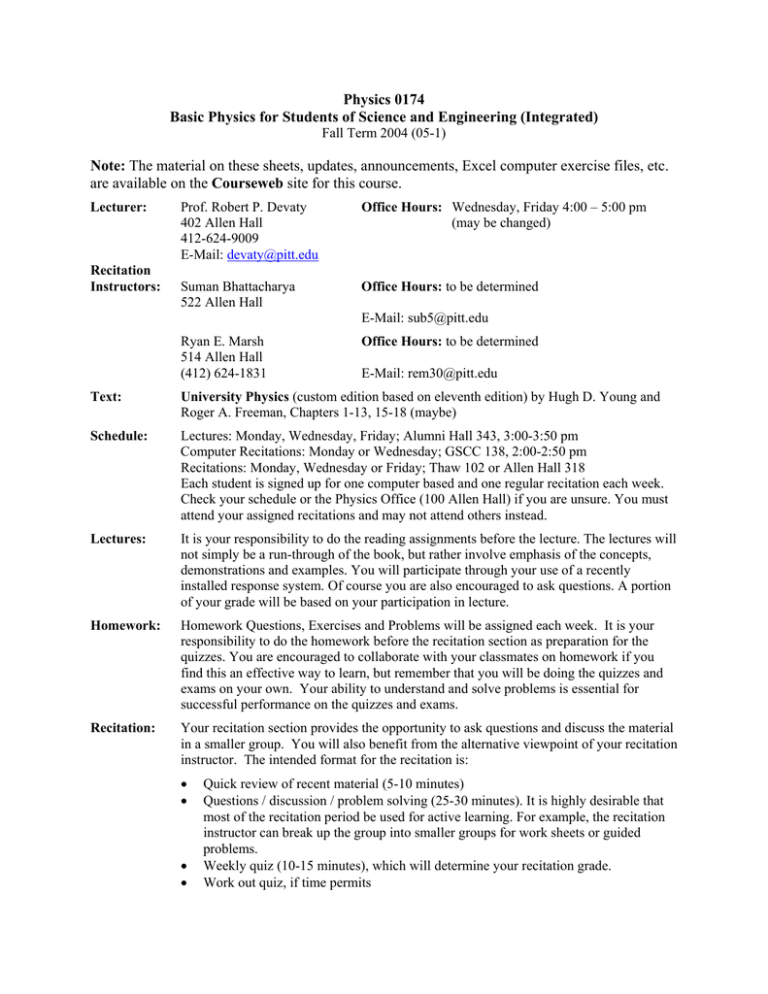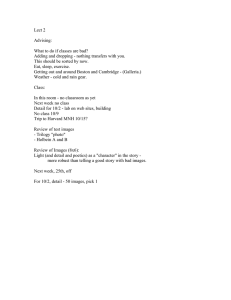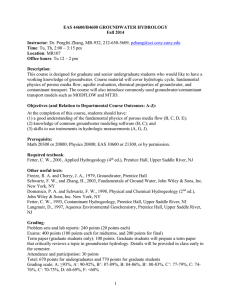Physics 0174 Basic Physics for Students of Science and
advertisement

Physics 0174 Basic Physics for Students of Science and Engineering (Integrated) Fall Term 2004 (05-1) Note: The material on these sheets, updates, announcements, Excel computer exercise files, etc. are available on the Courseweb site for this course. Lecturer: Recitation Instructors: Prof. Robert P. Devaty 402 Allen Hall 412-624-9009 E-Mail: devaty@pitt.edu Office Hours: Wednesday, Friday 4:00 – 5:00 pm (may be changed) Suman Bhattacharya 522 Allen Hall Office Hours: to be determined E-Mail: sub5@pitt.edu Ryan E. Marsh 514 Allen Hall (412) 624-1831 Office Hours: to be determined E-Mail: rem30@pitt.edu Text: University Physics (custom edition based on eleventh edition) by Hugh D. Young and Roger A. Freeman, Chapters 1-13, 15-18 (maybe) Schedule: Lectures: Monday, Wednesday, Friday; Alumni Hall 343, 3:00-3:50 pm Computer Recitations: Monday or Wednesday; GSCC 138, 2:00-2:50 pm Recitations: Monday, Wednesday or Friday; Thaw 102 or Allen Hall 318 Each student is signed up for one computer based and one regular recitation each week. Check your schedule or the Physics Office (100 Allen Hall) if you are unsure. You must attend your assigned recitations and may not attend others instead. Lectures: It is your responsibility to do the reading assignments before the lecture. The lectures will not simply be a run-through of the book, but rather involve emphasis of the concepts, demonstrations and examples. You will participate through your use of a recently installed response system. Of course you are also encouraged to ask questions. A portion of your grade will be based on your participation in lecture. Homework: Homework Questions, Exercises and Problems will be assigned each week. It is your responsibility to do the homework before the recitation section as preparation for the quizzes. You are encouraged to collaborate with your classmates on homework if you find this an effective way to learn, but remember that you will be doing the quizzes and exams on your own. Your ability to understand and solve problems is essential for successful performance on the quizzes and exams. Recitation: Your recitation section provides the opportunity to ask questions and discuss the material in a smaller group. You will also benefit from the alternative viewpoint of your recitation instructor. The intended format for the recitation is: • • • • Quick review of recent material (5-10 minutes) Questions / discussion / problem solving (25-30 minutes). It is highly desirable that most of the recitation period be used for active learning. For example, the recitation instructor can break up the group into smaller groups for work sheets or guided problems. Weekly quiz (10-15 minutes), which will determine your recitation grade. Work out quiz, if time permits Computer-Based Recitation: The computer based recitation will give you experience in applying computers, using Excel, to explore physics and solve problems. You will belong to a group of up to three students for this part of the course. You may not be able to complete a particular assignment during the recitation period. You can take your work home by copying it onto a diskette or e-mailing (or ftp) the Excel file to yourself. Typically, the first worksheet of an Excel recitation exercise for a given week will be a Summary Sheet. You will be instructed to print out this sheet and hand it in for grading. Be sure to copy your properly labeled plots to the Summary Sheet, if requested, before printing it out. If you need a fresh copy of the Excel assignment, it will be available on the Courseweb site under “Course Documents” after it is presented in the recitation. Examinations: There will be two preliminary examinations, given during regular lecture periods. The scheduled dates are October 1 and November 12, both Fridays. The comprehensive final examination is scheduled by the University for Wednesday, December 15, from 8:00 9:50 am. Grading: Each preliminary examination will be worth 100 points. The final examination will be worth approximately 150 points. The recitation grade, based on the quizzes, will be normalized to 50 points. Some (perhaps two) of your lowest quiz scores will be dropped. The Summary Sheets from the computer-based recitations will also contribute 50 points. Checks of handed in homework and responses in lecture will also contribute perhaps 50 points together. The entire course will be worth about 500 points. Your grade will be determined by how many points you earn, relative to the totals earned by your peers. Academic Integrity: Students in this course will be expected to comply with the University of Pittsburgh's Policy on Academic Integrity. Any student suspected of violating this obligation for any reason during the semester will be required to participate in the procedural process, initiated at the instructor level, as outlined in the University Guidelines on Academic Integrity. This may include, but is not limited to, the confiscation of the examination of any individual suspected of violating University Policy. Furthermore, no student may bring any unauthorized materials to an exam, including dictionaries and programmable calculators. Disabilities: If you have a disability that requires special testing accommodations or other classroom modifications, you need to notify both the instructor and the Disability Resources and Services as early as possible, say no later than the 2nd week of the term. You may be asked to provide documentation of your disability to determine the appropriateness of accommodations. To notify Disability Resources and Services, call (412) 648-7890/(412) 383-7355 (TTY) to schedule an appointment. The Office is located in 216 William Pitt Union. A comprehensive description of the services of this office can be obtained at www.drs.pitt.edu. Assignment for Week #1: Reading: Chapter 1, Sections 1-9; Appendices A, B (first page), and E; Chapter 2, Sections 1-3 Homework: Due Week #2 (at Lecture, Wednesday after Labor Day) Chapter 1: Questions 2, 8, 10, 12, 18; Exercises 2, 7, 35, 42, 48 Assignment for Week #2: Reading: Chapter 2, Sections 4– 5; Chapter 3, Sections 1-5 Homework: Due Week #3 Chapter 2: Questions 2, 9, 12, 14, 20; Exercises 1, 12, 24, 31, 32 Physics 0174 Weekly Topics (Approximate Schedule) R.P. Devaty Week #1 Aug 30 (M) Sep 01 (W) Sep 03 (F) Week #2 Sep 06 (M) Sep 08 (W) Sep 10 (F) Week #3 Sep 13 (M) Sep 15 (W) Sep 17 (F) Week #4 Sep 20 (M) Sep 22 (W) Sep 24 (F) Week #5 Sep 27 (M) Sep 29 (W) Week #6 Oct 01 (F) Oct 04 (M) Oct 06 (W) Oct 08 (F) Week #7 Oct 11 (M) Oct 13 (W) Oct 15 (F) Week #8 Oct 18 (M) Oct 20 (W) Oct 22 (F) Lect 1: organizational details, course overview and teaching philosophy; the nature of physics; systems of units; dimensional analysis; measurement uncertainty and significant figures; scientific notation; Lect 2: mathematical tools - trigonometric functions; scalars and vectors; vector addition and subtraction; illustrative examples Lect 3: motion in one dimension: variables used to describe motion - position, displacement, velocity, and acceleration; motion diagrams; illustrations Labor Day – no lecture Lect 4: mathematical description of 1-D motion – kinematic equations for constant acceleration; examples Lect 5: generalization to motion in two and three dimensions; examples of 2-D motion: projectiles and objects in uniform circular motion; relative velocity Lect 6: methodical approach to solving motion problems; illustrative examples Lect 7: forces – definition; common types of forces (weight, normal force, tension, frictional force); identifying the forces acting on an object; free-body force diagrams; finding the net force Lect 8: relationship between net force and motion: Newton’s First Law; Newton’s Second Law; definition of mass; Newton’s Third Law Lect 9: applications of Newton’s Laws - illustrative 1-D examples of particles in equilibrium and particle dynamics Lect 10: generalization to problems in 2-D; choosing a coordinate system and decomposing forces; determining the magnitude and direction of the frictional force; illustrative examples; dynamics of circular motion Lect 11: interaction forces and Newton’s Third Law; two approaches to solving problems that involve coupled objects Lect 12: the concepts of work and kinetic energy; definition of work as dot product of force and displacement vectors; illustrative examples Lect 13: work-energy theorem; work done by a variable force; power – the rate of doing work; pre-examination review 1st hour-examination (material since start of course) Lect 14: kinetic vs. potential energy; transformation of energy from one type into another; illustrations; gravitational potential energy and elastic potential energy Lect 15: conservative and non-conservative forces; force and potential energy Lect 16: the conservation of mechanical energy law - what does it mean and when does it apply? How to take advantage of it in solving problems? illustrative examples Lect 17: the concepts of impulse and linear momentum; the impulsemomentum theorem; Lect 18: the conservation of linear momentum law: when does it apply? Illustrative examples Lect 19: application to collision problems; elastic vs. inelastic collisions; the concept of center of mass Lect 20: rotation of rigid bodies: angular displacement, angular velocity, and angular acceleration; examples of rigid body rotations; relationships between linear and angular kinematic variables; rolling motion Lect 21: rotational kinetic energy; rotations with constant angular acceleration; illustrative examples Lect 22: the concept of moment of inertia; examples of calculating the moment of inertia for objects of different shapes; the Parallel Axis Theorem Week #9 Oct 25 (M) Oct 27 (W) Oct 29 (F) Week #10 Nov 01 (M) Nov 03 (W) Week #11 Nov 05 (F) Nov 08 (M) Nov 10 (W) Week #12 Nov 12 (F) Nov 15 (M) Nov 17 (W) Nov 19 (F) Week #13 Nov 22 (M) Week #14 Nov 24 (W) Nov 26 (F) Nov 29 (M) Dec 01 (W) Dec 03 (F) Week #15 Dec 06 (M) Dec 08 (W) Dec 10 (F) Week #16 Lect 23: dynamics of rotational motion: the concept of torque; Newton’s Second Law for rotational motion; illustrative examples Lect 24: work and power in rotational motion; definition of angular momentum; the conservation of angular momentum law and when it applies; examples Lect 25: conditions for equilibrium; examples of rigid-body equilibrium problems Lect 26: Newton’s Law of Gravitation; weight vs mass; gravitational potential energy Lect 27: applications of Newton’s Law of Gravitation – the motion of satellites and planets Lect 28: Kepler’s Laws and the motion of the Earth’s planets Lect 29: periodic motion and simple harmonic motion: the equations used to describe SHM; example: mass on a spring Lect 30: conservation of total mechanical energy in SHM; pre-examination review 2nd hour-examination (material since 1st examination) Lect 31: periodic motion (continued) - the simple pendulum; the physical pendulum; damped oscillations Lect 32: forced oscillations and resonance phenomena Lect 33: mechanical waves – transverse vs longitudinal waves; mathematical description of a wave; speed of a transverse wave Lect 34: waves on strings and sound waves; energy transmitted in wave motion Thanksgiving Break – no lecture Thanksgiving Break – no lecture Lect 35: the principle of superposition; wave interference; standing waves Lect 36: normal modes of a string; resonance; examples Lect 37: sound waves – generation, transmission, reception; sound intensity; interference patterns; beat frequency; the Doppler effect Lect 38: temperature and thermal equilibrium; temperature scales; definition of heat; specific heat; phase changes Lect 39: thermal properties of matter; equations of state; kinetic-molecular model of an ideal gas; heat capacities at constant pressure and at constant volume Lect 40: pre-final examination review of course material Dec 15 (W) 8:00–9:50 am (place to be announced) Final Examination (all material covered in the course)



